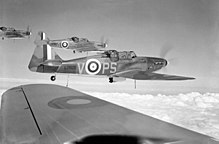Boulton Paul Aircraft
| Boulton Paul Aircraft Ltd
|
|
|---|---|
| legal form | Limited Company |
| founding | 1934 |
| resolution | 1961 |
| Seat | Wolverhampton , UK |
| Branch | Aircraft construction |
Boulton Paul Aircraft Limited was a British aircraft manufacturer based in Norwich , later Wolverhampton . The company, founded in 1934, emerged from the aircraft construction division of Boulton & Paul Ltd , which had existed since 1914 , and merged with the Dowty Group in 1961 . It mainly produced and improved models from other manufacturers. In addition, some notable own designs were created.
history
Beginnings
Boulton & Paul Ltd , which has existed since 1797, began producing aircraft from other manufacturers in 1915. The most important model from the time of the First World War was the Royal Aircraft Factory FE2 , of which 550 copies were made. In addition, Boulton Paul was the most important producer of the Sopwith Camel . Although in the meantime its own design office had been established, no design of its own gained greater importance during the war. While the Sopwith Snipe was preferred to the P.3 Bobolink fighter aircraft , the armistice prevented the P.7 Bourges from starting production .
Interwar period
After the war, the company focused on developing machine gun turrets to be built into bombers. The twin-engine double-decker Sidestrand had an ultimately unsatisfactory tower in the bow. The successor Overstrand received a closed turret with a Lewis machine gun that could be moved with compressed air. The company later acquired a French license that enabled the transition to electro-hydraulic drives. The towers were then also intended for combat aircraft.
independence
1934 Boulton & Paul separated from the aircraft division that from now on as Boulton Paul Aircraft Ltd. was out. In the following years, a new production site was built in Wolverhampton. The old Norwich factories were abandoned.
The first fighter aircraft equipped with a turret was the Hawker Demon . A short time later, a new design followed, the Defiant , which, however, did not meet the high expectations. Instead of a frontal armament, the aircraft had a turret with four machine guns behind the cockpit. The same armament was found in the Blackburn Roc naval aircraft , redesigned and manufactured by Boulton Paul.
Another model made by Boulton Paul during World War II was the Fairey Barracuda . In addition, modifications were carried out on the Vickers Wellington .
post war period
The only significant post-war design was the Balliol training aircraft , of which 229 were built. Of these, thirty models were used as Sea Balliols to practice landings on aircraft carriers.
Boulton Paul later participated in the making of the English Electric Canberra and the de Havilland DH.100 Vampires . The company designed and built a number of jet-powered delta wing aircraft for testing purposes .
In 1961 it merged with the Dowty Group . As a result, Dowty Boulton Paul Ltd was created , from which the company Dowty Aerospace emerged . The aviation company has been part of Smiths Aerospace since 2000 .
Planes
- Boulton & Paul Bobolink 1918
- Boulton & Paul Bourges 1918
- Boulton & Paul P-6 1918
- Boulton & Paul Atlantic 1919
- Boulton & Paul P. 9 1919
- Boulton & Paul Bolton 1922
- Boulton & Paul Bugle 1923
- Boulton & Paul Bodmin 1924
- Boulton & Paul Sidestrand 1926 - Bomber
- Boulton & Paul Bittern 1927
- Boulton & Paul Partridge 1928
- Boulton & Paul Phoenix 1929
- Boulton & Paul P. 32 1931
- Boulton & Paul Overstrand 1933-Bomber
- Boulton & Paul P. 64 Mailplane 1933 - transport plane
- Boulton & Paul P.71A 1934 - transport plane
- Boulton Paul Defiant 1937 - turret fighter aircraft
- Boulton Paul P.92 1941
- Boulton Paul Balliol 1947 - coach
- Boulton Paul P. 111 1950 - Delta wing
- Boulton Paul P. 120 1952 - Delta wing
Guided missiles
- UB.109T - internal name Boulton-Paul P.123

